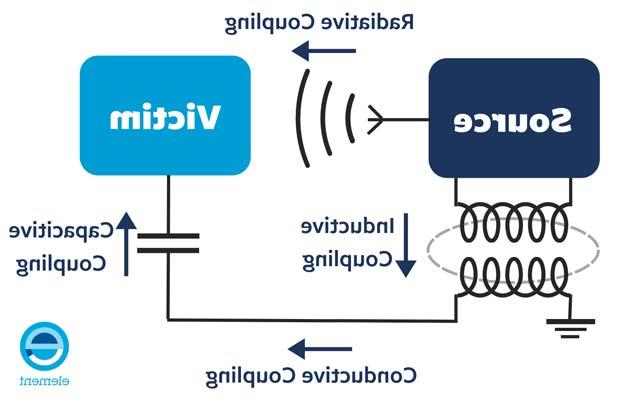EMC与EMI测试,有什么区别?

专职专家
史蒂夫·海斯史蒂夫·海斯 has over 30 years of experience in the product approvals industry and serves on numerous national and international standards committees.
有没有想过为什么术语像 电磁兼容性(EMC) 和电磁干扰(EMI)经常交织在一起? 这两个核心概念, 对保护你的电子设备免受干扰至关重要, are closely related - but it is important to understand that EMC and EMI are not the same. 那么,EMI到底是什么,它与EMC有什么不同? 在本文中, Element expert 史蒂夫·海斯 discusses the critical differences between EMC and EMI and explores which one is most effective for minimizing risk in different scenarios.
EMC和EMI的区别是什么?
The purpose of EMI and EMC tests is to ensure that electronic and electrical devices, systems, and equipment can operate properly and coexist in their intended electromagnetic 环境s without causing or suffering from unacceptable levels of electromagnetic interference. 由于各种原因,这些测试至关重要:
- 确保产品无干扰运行.
- 遵守法规和标准.
- 提高可靠性和安全性.
- 验证与其他设备的兼容性.
- 保持客户满意度.
什么是电磁兼容性(EMC)?
- 排放: EMC considers the electromagnetic energy emitted by a device during its operation. This includes signals radiated through the air or conducted along cables.
- Immunity: EMC等式的另一边是免疫. This involves the device's ability to continue functioning correctly despite being exposed to electromagnetic disturbances from other sources, 比如附近的发射机或电气设备.
从根本上, the compatibility aspect ensures that we can have one electrical device used in close proximity to another electrical device without causing electrical interference.
什么是电磁干扰(EMI)?
Electromagnetic Interference (EMI) arises from electromagnetic disturbances, 影响电子设备的功能. 这些干扰可能有各种来源, including 环境al factors like electrical storms or other electronic devices/systems. 如果干扰发生在无线电频谱内, 通常被称为射频干扰(RFI).
Electromagnetic interference (EMI) can be categorized into several types based on their sources and characteristics. 常见的电磁干扰类型包括:
- 辐射电磁干扰: 通过空气以波的形式发射的电磁干扰, 通常来自无线电或无线路由器等设备.
- EMI进行: 电线或电缆上的干扰, typically caused by electrical devices such as motors or power supplies.
- 耦合的电磁干扰: Interference transferred from one circuit or transmission line to another through electromagnetic fields, 导致串扰或信号失真.
These types of interference can disrupt electronic systems and communication networks, requiring mitigation strategies like shielding and filtering for optimal performance.

确定使用哪种EMI/EMC测试
The device’s intended application will determine the exact type of testing required.
要问的关键问题有:
- 这个产品会用在哪里?
- 它会干扰什么/谁?
- 能量如何从产品传递到“受害者”?
The two key methods that electromagnetic activity or ‘energy’ can reach a product through are the air (radiative coupling) or the cabling (conductive coupling). The standards used are therefore based primarily on radiated and conducted tests.
如何设计EMI & EMC降低风险?
Electromagnetic compatibility (EMC) and interference (EMI) are both extremely important design considerations. Failing to consider them in the initial stages of product development can result in the time-consuming and costly need to redesign the product at a later stage to meet EMC/EMI specification tests and prevent product failure or safety risk.
如果产品必须重新设计, it can be prohibitively expensive and result in delays to market and a loss in consumer confidence.
糟糕的产品设计 (从EMC或EMI的角度来看)将是在接地时, filtering, 屏蔽还没有被考虑到. The result of this would include product failure during tests and in the real world would mean that the product would be unreliable and not work as intended.
优秀的产品设计 结合基本的应用 电磁兼容原理 比如有效屏蔽, earthing, and filtering will simultaneously improve electromagnetic immunity and reduce electromagnetic emissions, 同时将风险降到最低.
Conclusion
Understanding the distinction between 电磁兼容性(EMC) and Electromagnetic Interference (EMI) is crucial for ensuring the seamless operation of electronic devices in their intended 环境s because it allows engineers and designers to effectively manage the risks associated with electromagnetic disturbances.
While EMI focuses on disruptions caused by electromagnetic disturbances to device performance, EMC evaluates a device's ability to function without affecting neighboring devices. This differentiation is essential because it enables targeted mitigation strategies to be implemented.
Our laboratories and EMC test facilities hold ISO/IEC 17025 accreditation from UKAS, NVLAP, A2LA, or DAkkS. 我们得到了欧洲电磁兼容指令等权威机构的认可, 英国EMC法规, FCC, and appointed as a Technical Service by the Vehicle 认证 Agency.
For advice and support on EMC and EMI testing and compliance or Advisory Services, 请im体育APP. 要了解更多关于我们在这一领域的专业知识,请访问我们的 关于我们页面.
找到相关的 Resources
准备好进行EMC测试了吗?
Element的专家团队整理了一份8点清单, to help ensure that you are fully prepared to present a device for EMC testing.
来自Element的更多信息

EMC测试服务
Find out how Element delivers electromagnetic compatibility testing (EMC) solutions to RTCA/DO-160, MIL-STD-461和Def-Stan 59-411标准.

易于理解的EMC原理
Electromagnetic Compliance (EMC) is often described as a ‘Black Art’ but the key to unlocking it is to understand its basic principles. 阅读我们的文章了解更多.

EMC风险评估
EMC风险评估是分析的组合 & 评估与产品相关的潜在电磁危害 & 环境. 阅读我们的免费指南.

您的EMC计划和检查清单
Reviewing these eight key questions before EMC testing will enable you to better prepare for future testing.



